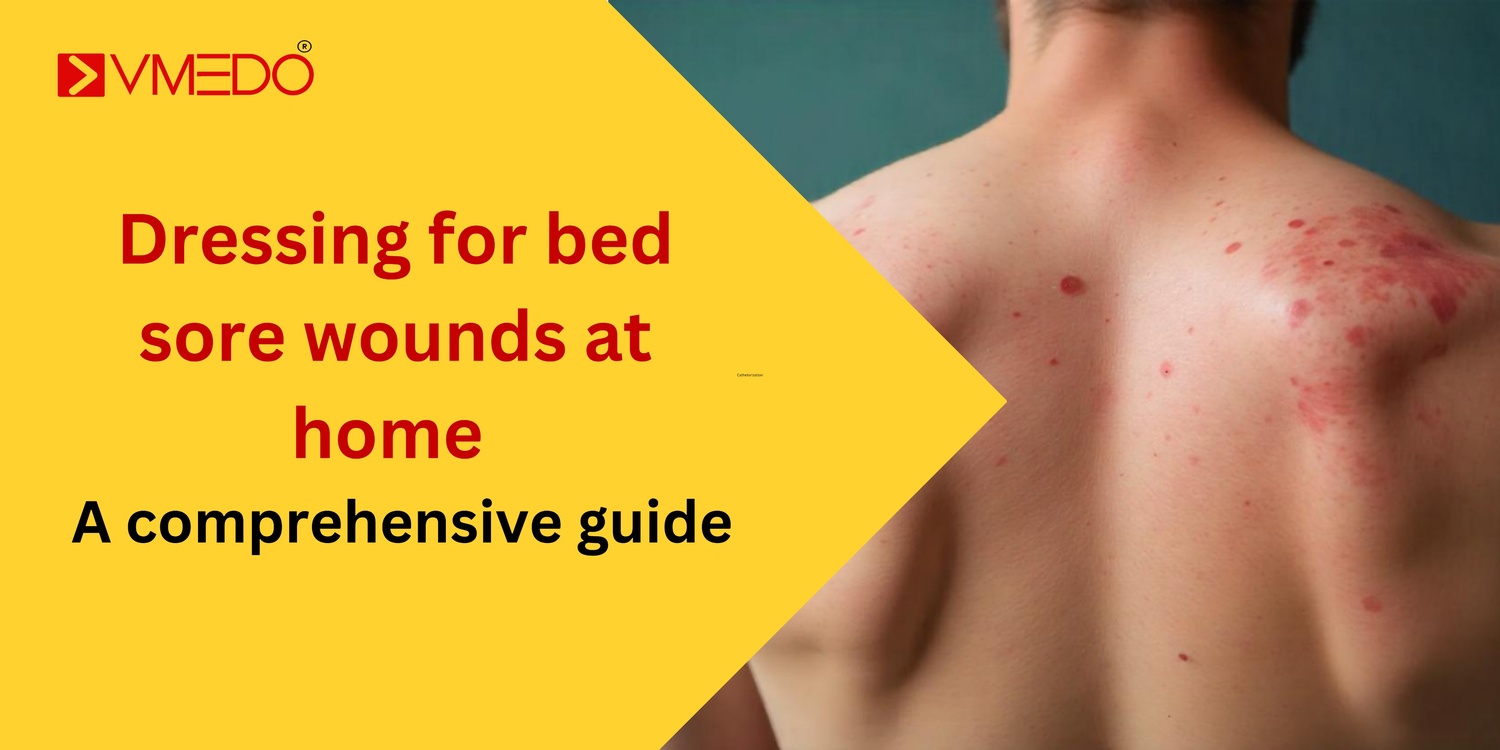Bed sores, also known as pressure ulcers, are a common issue among individuals with limited mobility. These sores develop when prolonged pressure on the skin cuts off circulation, leading to tissue damage. Proper wound care is essential to prevent infection, promote healing, and minimize discomfort. Dressing bed sores at home is a critical component of treatment, and it requires careful attention to hygiene, moisture balance, and wound protection.
In this comprehensive guide, we’ll cover the types of dressings suitable for bed sores, how to apply and change dressings, and tips on managing bed sore wounds at home. We will also introduce how VMEDO can assist with professional home care services in Bangalore.
Types of Dressings for Bed Sores
Various dressings are available to treat bed sores at different stages. Choosing the right dressing is crucial to promoting healing, maintaining moisture balance, and preventing infection. Here are some commonly used dressings for bed sores:
1. Hydrocolloid Dressings
Hydrocolloid dressings are ideal for stage 1 and stage 2 bed sores. These dressings are designed to create a moist environment that promotes healing while protecting the wound from bacteria and dirt.
- How It Works: Hydrocolloids contain substances like gelatin that form a gel when they come into contact with wound exudate. This gel keeps the wound moist, accelerating healing.
- When to Use: Stage 1 or 2 bed sores, minimal exudate.
- Advantages:
- Promotes healing in clean, shallow wounds.
- Requires fewer dressing changes.
- Provides a waterproof barrier.
2. Foam Dressings
Foam dressings are thick, absorbent dressings used for bed sores with moderate to heavy drainage. They help maintain a moist environment while absorbing excess fluid.
- How It Works: The foam absorbs excess exudate from the wound while preventing the skin from becoming overly dry.
- When to Use: Stage 2 or 3 bed sores, moderate exudate.
- Advantages:
- Highly absorbent, prevents maceration.
- Cushions and protects the wound from further trauma.
- Easy to apply and remove.
3. Alginate Dressings
Alginate dressings are made from seaweed and are highly absorbent. They are suitable for bed sores that produce heavy exudate, particularly stage 3 and stage 4 sores.
- How It Works: Alginate forms a gel when it comes into contact with wound exudate, creating a moist environment while controlling the fluid level.
- When to Use: Stage 3 or 4 bed sores with heavy exudate.
- Advantages:
- Excellent for heavily draining wounds.
- Can handle infection when used with an appropriate antimicrobial agent.
- Helps in debriding (removing dead tissue).
4. Hydrogel Dressings
Hydrogel dressings are designed to add moisture to dry wounds, making them ideal for bed sores that need hydration, such as those in stage 2 or 3 with minimal exudate.
- How It Works: Hydrogel dressings are water- or glycerin-based, providing moisture to dry or necrotic tissue to encourage healing.
- When to Use: Stage 2 or 3 bed sores, dry wounds, or necrotic tissue.
- Advantages:
- Rehydrates dry wounds and necrotic tissue.
- Helps soften and remove dead tissue (autolytic debridement).
- Provides a cooling, soothing effect on the wound.
5. Transparent Film Dressings
Transparent film dressings are thin, flexible dressings that create a moist environment to promote healing and protect the wound from outside contaminants.
- How It Works: Transparent films provide a waterproof barrier while allowing oxygen to reach the wound. They are often used as secondary dressings.
- When to Use: Stage 1 or 2 bed sores with minimal exudate.
- Advantages:
- Allows easy monitoring of the wound.
- Protects against bacteria and external fluids.
- Stays in place for several days, reducing the need for frequent changes.
6. Antimicrobial Dressings
These dressings are designed to reduce the risk of infection and are particularly useful for bed sores at risk of becoming infected. They often contain silver or iodine.
- How It Works: Antimicrobial dressings inhibit bacterial growth, protecting the wound from infection.
- When to Use: All stages of bed sores with signs of infection.
- Advantages:
- Reduces bacterial load in infected wounds.
- Can be combined with other types of dressings for comprehensive care.
How to Apply and Change Bed Sore Dressings at Home
Proper application and regular dressing changes are essential for effective bed sore management. Follow these steps for dressing a bed sore at home:
Step 1: Gather Supplies
Before starting, ensure you have all the necessary materials:
- Clean gloves
- Saline solution or wound cleanser
- Gauze or clean cloth for cleaning
- Appropriate wound dressing (hydrocolloid, foam, alginate, etc.)
- Scissors (if needed to cut dressings)
- Medical tape (if necessary)
Step 2: Clean the Wound
Gently clean the wound to remove any dead tissue, bacteria, or debris. Use a saline solution or wound cleanser to irrigate the wound. Avoid using harsh antiseptics like hydrogen peroxide or iodine, as they can damage healthy tissue.
Step 3: Dry the Surrounding Skin
Pat the skin around the bed sore dry using a clean gauze pad or cloth. Avoid rubbing, which can cause further damage to the skin.
Step 4: Apply the Dressing
- Hydrocolloid or Foam Dressings: Cut the dressing to fit the wound, ensuring that it covers the sore completely. Press it down gently to secure it.
- Alginate Dressings: For deep or heavily exudating wounds, pack the alginate dressing into the wound and cover it with a secondary dressing.
- Hydrogel Dressings: Apply a thin layer of hydrogel to the wound and cover it with a secondary dressing if needed.
- Antimicrobial Dressings: Apply directly to the wound if there are signs of infection, and cover with a secondary dressing.
Step 5: Secure the Dressing
If the dressing does not have adhesive backing, secure it with medical tape. Ensure the dressing is not too tight, as this can cut off circulation.
Step 6: Change Dressings Regularly
Change dressings according to the healthcare provider’s instructions or if the dressing becomes wet, soiled, or begins to peel away. Typically, most dressings need to be changed every 1-3 days.
Preventing Infection and Promoting Healing
To prevent infection and encourage faster healing, follow these additional tips:
- Keep the wound clean and dry: Clean the wound with saline before each dressing change.
- Monitor for signs of infection: Look for redness, warmth, swelling, pus, or a foul odor around the wound. If you notice these signs, seek medical attention.
- Encourage a healthy diet: Proper nutrition, including adequate protein, vitamins, and hydration, is essential for wound healing.
- Reposition regularly: Avoid putting pressure on the bed sore by repositioning the patient frequently (every 2 hours for bedridden individuals, every 15-30 minutes for wheelchair users).
When to Seek Professional Help
Proper application and regular dressing changes are essential for effective bed sore management. Follow these steps for dressing a bed sore at home:
Step 1: Gather Supplies
Before starting, ensure you have all the necessary materials:
- Clean gloves
- Saline solution or wound cleanser
- Gauze or clean cloth for cleaning
- Appropriate wound dressing (hydrocolloid, foam, alginate, etc.)
- Scissors (if needed to cut dressings)
- Medical tape (if necessary)
Step 2: Clean the Wound
Gently clean the wound to remove any dead tissue, bacteria, or debris. Use a saline solution or wound cleanser to irrigate the wound. Avoid using harsh antiseptics like hydrogen peroxide or iodine, as they can damage healthy tissue.
Step 3: Dry the Surrounding Skin
Pat the skin around the bed sore dry using a clean gauze pad or cloth. Avoid rubbing, which can cause further damage to the skin.
Step 4: Apply the Dressing
- Hydrocolloid or Foam Dressings: Cut the dressing to fit the wound, ensuring that it covers the sore completely. Press it down gently to secure it.
- Alginate Dressings: For deep or heavily exudating wounds, pack the alginate dressing into the wound and cover it with a secondary dressing.
- Hydrogel Dressings: Apply a thin layer of hydrogel to the wound and cover it with a secondary dressing if needed.
- Antimicrobial Dressings: Apply directly to the wound if there are signs of infection, and cover with a secondary dressing.
Step 5: Secure the Dressing
If the dressing does not have adhesive backing, secure it with medical tape. Ensure the dressing is not too tight, as this can cut off circulation.
Step 6: Change Dressings Regularly
Change dressings according to the healthcare provider’s instructions or if the dressing becomes wet, soiled, or begins to peel away. Typically, most dressings need to be changed every 1-3 days.
Preventing Infection and Promoting Healing
To prevent infection and encourage faster healing, follow these additional tips:
- Keep the wound clean and dry: Clean the wound with saline before each dressing change.
- Monitor for signs of infection: Look for redness, warmth, swelling, pus, or a foul odor around the wound. If you notice these signs, seek medical attention.
- Encourage a healthy diet: Proper nutrition, including adequate protein, vitamins, and hydration, is essential for wound healing.
- Reposition regularly: Avoid putting pressure on the bed sore by repositioning the patient frequently (every 2 hours for bedridden individuals, every 15-30 minutes for wheelchair users).
When to Seek Professional Help
While many bed sores can be managed at home, severe cases or those showing signs of infection require professional care. Call a doctor or healthcare provider if:
- The bed sore is getting worse or not healing.
- There are signs of infection, such as pus, fever, or foul odor.
- The patient is in severe pain or discomfort.
VMEDO provides professional in-home nursing care, wound management, and telehealth consultations to support the treatment of bed sores in Bangalore.
How VMEDO Can Help with Bed Sore Dressing and Treatment at Home
VMEDO offers specialized home healthcare services in Bangalore, designed to help individuals manage bed sores effectively. Here’s how we can assist:
- In-Home Nursing Care: Our nurses are experienced in wound care and can help with cleaning, dressing, and monitoring bed sores.
- Pressure-Relieving Equipment: VMEDO offers pressure-relieving mattresses and cushions to help reduce the risk of further sores.
- Telehealth Consultations: We provide virtual consultations with healthcare professionals to guide you through the care process.
- Caregiver Training: We offer guidance and training for caregivers on how to manage bed sores and apply dressings properly.



